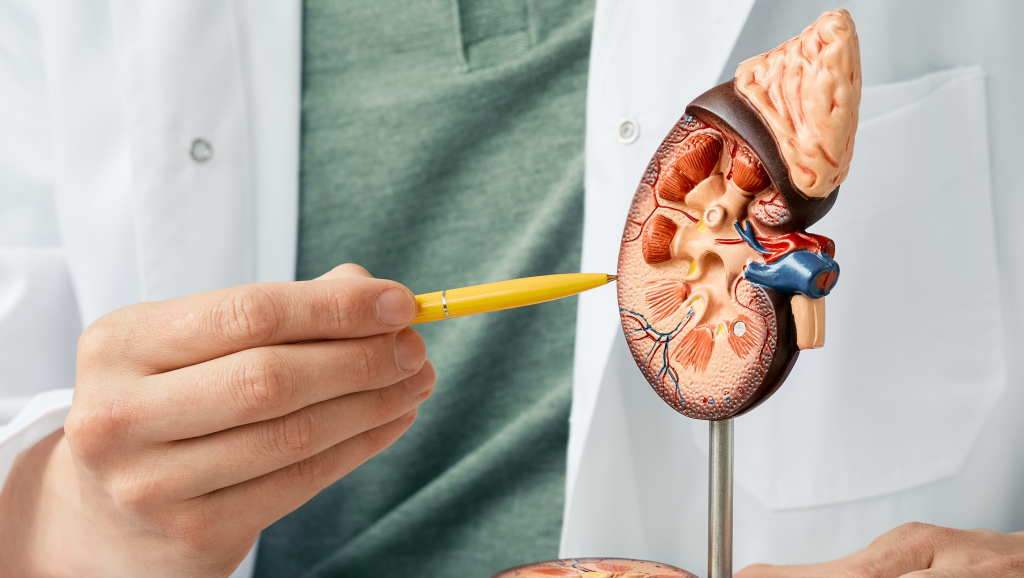URIC ACID AND KIDNEY DAMAGE

URIC ACID AND KIDNEY DAMAGE
By Dr. Ruel Agni, IM-Nephrology
In chronic kidney disease (CKD), there is gradual loss of kidney function overtime. Waste product called uremic toxins will build up in the blood and make patients feel sick. Kidney problems lead to kidney failure, a condition that requires renal replacement therapy like dialysis or kidney transplantation.
Early detection of CKD can prevent the progression of kidney disease to kidney failure. Simple tests can detect CKD: blood pressure, urine albumin and serum creatinine. High risk groups include diabetes, hypertension, and family history of kidney failure. Early-stage CKD is largely asymptomatic. There is a wide range of rates of decline in glomerular filtration rate (GFR) among CKD patients. This group may benefit from specialist intervention to slow down CKD progression.
The leading causes of CKD are diabetes and high blood pressure. Other conditions include glomerulonephritis (group of diseases that cause inflammation and scarring of the filter units of the kidneys), polycystic kidneys (inherited disease forming large cysts that destroy the normal structure of the kidneys), autoimmune diseases (like systemic lupus erythematosus), kidney stones causing obstruction and repeated urinary tract infections.
Another important cause of CKD is uric acid nephropathy. In humans, uric acid is the final breakdown product of purine metabolism and is excreted in urine. If metabolism generates extra uric acid or if the kidneys cannot clear enough of it. hyperuricemia develops.
Hyperuricemia is a common consequence of chronic renal failure and also contribute to CKD progression. lt is an independent risk factor for subsequent increase in creatinine, decrease in estimated GFR and development of CKD. The potential mechanisms that contribute to CKD progression are exacerbation of glomerular hypertension, endothelial dysfunction and proinflammatory effects.
Hyperuricosuria may result in crystalluria and uric acid stones formation. The lack of uricase in humans normally cause high levels of uric acid in the plasma and urine. Both hyperuricosuria and low urinary volume can increase the supersaturation of uric acid and cause crystallization. Foods and drinks that are rich in uric acid include: red meat, organ meat, seafood, beer, liquor, and foods with high fructose corn syrup. Large uric acid load is associated with malignancy especially after chemotherapy.
It is now clear that uric acid nephrolithiasis is part of a cluster of metabolic disturbances. The onset of a uric acid stone may be a sign of a systemic metabolic syndrome. Conversely, patients with the metabolic syndrome are at heightened risk for uric acid nephrolithiasis.
Uric acid excretion is not elevated in the majority of patients with uric acid nephrolithiasis. The principal defect is excessively acidic urine. At a, Urine pH of 5.5, solubility can be exceeded with a total uric acid concentration slightly above 200 mg/L. At a Urine pH of 6.5, urine can accommodate total uric acid concentration of more than 1000 mg/L.
The common causes of low urinary pH include increased base loss from diarrhea and upper gastrointestinal enterostomy, increased acid intake during high consumption of animal protein, increased endogenous acid production associated with insulin resistance states and exercise- induced lactic acidosis and decreased 110 urinary ammoniums associated with gout and insulin resistance states.
Cross-sectional data demonstrated that patients who formed idiopathic uric acid stones
have many features of the metabolic syndrome, all of which are linked to insulin resistance. An inverse relationship was demonstrated between body weight and urine pH in stone-forming subjects.
Uric acid stones are radiolucent on plain radiographs but are visualized on CT scan. A 24-h urine sample to evaluate for urine volume and pi I hyperuricosuria and markers of excessive purine and acid load.
There are various ways alkalinize the urine. Potassium citrate is preferred because it reduces urinary calcium, decreasing the risk for formation of calcium oxalate stones. Sodium citrate or sodium bicarbonate can be used as alternative. Orange and grapefruit juice exert citraturic and alkalinizing effects. The goal is to maintain urinary pH above 6.1 but less than 7.
Kidney failure is usually permanent. When GFR is <15 mL/min, renal function already declined by about 85-90%. Dialysis be needed to sustain life and to keep the body in balance.
The Palawan MMG Multipurpose Cooperative Hospital Dialysis Unit has been in operation since 2014. it started as a unit but in less than 2 years. expanded to 10 units using the latest model, state of the art hemodialysis machines. It will continue to provide renal patients from all parts of the Palawan with quality dialysis treatment through our well-trained hemodialysis nurses and certified kidney specialists.
References:
- Brenner 3rd Rector’s The Kidney 9th Edition
- National Kidney Foundation A to Z Health Guide
- KDOQI Guidelines
